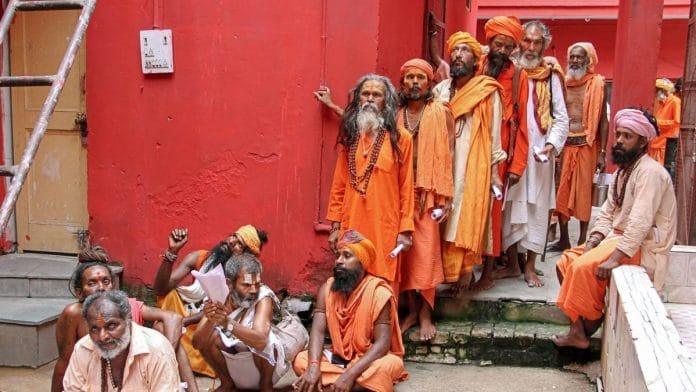Thank you dear subscribers, we are overwhelmed with your response.
Your Turn is a unique section from ThePrint featuring points of view from its subscribers. If you are a subscriber, have a point of view, please send it to us. If not, do subscribe here: https://theprint.in/subscribe/
Every year, thousands of Hindu pilgrims brave the treacherous mountain terrain to reach the sacred Amarnath cave in Kashmir, where a naturally formed ice lingam is venerated as a manifestation of Lord Shiva. For the yatris, it is a journey of devotion. But for successive Indian governments, particularly in recent decades, the Amarnath Yatra has been increasingly transformed from a spiritual expedition into a potent symbol of political dominance.
Historically, the Amarnath Yatra was modest in scale. Its origins go back centuries, and Kashmiri Muslims played a crucial role in facilitating it—providing food, shelter, ponies, and guiding the yatris through the treacherous mountain paths. This annual ritual was not just a religious event but a testament to Kashmir’s syncretic culture—where Sufi mysticism and Shaivite devotion coexisted in a delicate balance.
Even at the height of regional tensions, there were moving scenes of Kashmiri Muslims praying for the safety of the pilgrims, of gujjars and bakarwals volunteering for search and rescue efforts. For a brief period every summer, the region embodied a fragile unity.
But that fragile unity has been fraying—slowly, deliberately, and with political intent.
The late 1980s and early 1990s changed everything. The rise of militancy in Kashmir and the mass exodus of Kashmiri Pandits hardened perceptions. The Yatra, once low-profile and spiritually intimate, became securitized. With the shadow of conflict looming, the Indian state began using the pilgrimage to signal normalcy and assert control. The number of troops escorting the Yatra increased dramatically. So did the media spectacle.
It wasn’t just about faith anymore—it was about the optics of national sovereignty. And successive governments were quick to seize this opportunity.
If there was one moment that unmasked the politicization of the Yatra, it was the 2008 Amarnath Land Transfer Controversy. The government’s decision to transfer forest land to the Shri Amarnath Shrine Board (SASB) for setting up temporary pilgrim shelters triggered mass protests in the Valley. Kashmiri Muslims saw it as a demographic and ecological threat in the backdrop of wider fears of dispossession.
In response, counter-protests erupted in Jammu, leading to a summer of agitation, curfews, shutdowns, and deep communal fault lines. The incident exposed how the Yatra, instead of being a bridge between communities, had become a wedge. Politicians, particularly from the BJP, used it to galvanize support and portray Kashmiris as anti-Hindu and anti-national, while ignoring the nuanced local concerns of environmental degradation and cultural alienation.
Under the current BJP regime, the politicization of the Yatra has entered a new phase—marked by aggressive symbolism and a media-driven narrative. Pilgrim numbers are exaggerated, high-level visits by political leaders are broadcasted with patriotic fervor, and the presence of helicopters, drones, and military convoys makes the Yatra look less like a spiritual journey and more like a state-sponsored occupation.
After the abrogation of Article 370 in 2019, the Yatra was suspended amid fears of unrest. In a stark juxtaposition, while Kashmiris were locked down, deprived of internet, assembly, and basic freedoms, the state continued to brandish the Yatra as proof of a “unified” and “peaceful” Kashmir.
The irony was hard to miss: spiritual freedom for some, civil suffocation for others.
Beyond the political spectacle, the practical consequences have been severe. The environmental toll of an extended 40+ day Yatra is evident: shrinking glaciers, overwhelmed sanitation infrastructure, deforestation, and stress on fragile ecosystems. Experts have warned repeatedly, but the ecological concerns are drowned by nationalist rhetoric.
Kashmiri locals, once stakeholders in the pilgrimage, have been sidelined. The SASB, largely composed of non-Kashmiri bureaucrats, now calls the shots. The once-cooperative spirit between yatris and Muslim service providers is eroding under the weight of suspicion, surveillance, and securitization.
Trust is harder to rebuild than a tent or a trail.
At the heart of this transformation lies a troubling motive: to use faith as a tool of control. Successive governments, especially the current one, have found in the Yatra a potent symbol—one that evokes religious sentiment, galvanizes Hindu majoritarian support, and projects dominion over a contested land.
But when pilgrimage becomes propaganda, the spirit of faith is lost. What was once a deeply personal and communal act of devotion is now staged with military choreography and political overtones. Kashmiris, both Muslim and Pandit, lose in the process. So does India’s moral claim to secularism and pluralism.
If the Amarnath Yatra is to return to its roots—as a sacred journey of love, faith, and spiritual awakening—it must be depoliticized. Let it be modest again. Let it be safe, not militarized. Let it be a symbol of coexistence, not conquest.
India does not need to “prove” its sovereignty by amplifying religious pilgrimages in a disputed region. It needs to win hearts—genuinely, respectfully, and through dialogue, not drone footage.
And perhaps, when Kashmiri Muslims once again line the paths with offerings of kehwa and shelter, and yatris sing their bhajans without the echo of boots and barriers, we’ll know the pilgrimage has been reclaimed.
These pieces are being published as they have been received – they have not been edited/fact-checked by ThePrint.


